Iain M. Banks
Iain Banks Interview
In its preoccupation with privatisation and bottom lines, Railtrack, a dismembered limb of the former British Rail, has recently rejected responsibility for the vital task of painting the Forth Bridge, on the grounds  that it is a national monument. Indeed, the rail bridge bestriding the river Forth is a perennially thrilling entity. The well-loved image of this sturdy, unsubtle cat’s cradle of metal that so dramatically imposes its character on the scene is a worldwide symbol of Scotland. It was engrossed into the imagination of the young Iain Banks as he grew up in 1950s North Queensferry, and it inspired what he considers to be his best book, The Bridge. As the powers-that-be play pass the parcel with the job of preserving the real rail bridge against rust, raising the spectre of its ruin through neglect, it seems the right time to have a word with the bestselling author who brought about its strange literary apotheosis, and who, after extended sojourns elsewhere, has returned to stay in North Queensferry. Most of the following conversation is devoted to a discussion of his books in the order in which they were written, sometimes comparing early drafts with published versions.
that it is a national monument. Indeed, the rail bridge bestriding the river Forth is a perennially thrilling entity. The well-loved image of this sturdy, unsubtle cat’s cradle of metal that so dramatically imposes its character on the scene is a worldwide symbol of Scotland. It was engrossed into the imagination of the young Iain Banks as he grew up in 1950s North Queensferry, and it inspired what he considers to be his best book, The Bridge. As the powers-that-be play pass the parcel with the job of preserving the real rail bridge against rust, raising the spectre of its ruin through neglect, it seems the right time to have a word with the bestselling author who brought about its strange literary apotheosis, and who, after extended sojourns elsewhere, has returned to stay in North Queensferry. Most of the following conversation is devoted to a discussion of his books in the order in which they were written, sometimes comparing early drafts with published versions.
What do you have in your own book collection?
Far too many books. I lost count a long time ago. I used to keep a list of all the books I’d bought but hadn’t read. At university there were about fifty of them and I gradually whittled it down once I left to about ten. Now, I wouldn’t like to think how many hundreds it comprises.
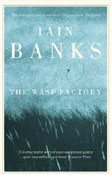 You’re a reader, not a collector, then?
You’re a reader, not a collector, then?
I’ve had lots of daft arguments about first editions. There were 5000 copies of the first edition of The Wasp Factory, but there were only 1500 copies of the second and third editions. Can you tell me, why is the first edition the valuable one? This is a great way to annoy book collectors, because they start to explain why the first edition is the important one.
Which authors are your favourites?
Jane Austen, Tolstoy, Graham Greene and Saul Bellow. Loads of underrated science fiction authors – M. John Harrison should be a megastar, but he probably couldn’t be because he’s too rarefied a taste, I suppose; John Sladeck, who should have been the Terry Pratchett of the Seventies; and I’ve always had a soft spot for Barrington J. Bayley.
Catch 22 and Fear and Loathing in Las Vegas are the last two books which had an enormous effect on me before I started to get my own stuff together. These are the two most influential books of my formative years. Everything you read affects you to some extent.
Have you any oddities in your library?
I was invited to the Edinburgh University Science Fiction & Fantasy Society’s Freshercon three or four years ago, and they had an entirely free and secret ballot for the book that the assembled patrons thought most deserved to be taken out to a rifle range, and the winner by a large margin was Dianetics by L. Ron Hubbard.  So this was duly taken out and shot full of bullet holes. It was flourished the next year, and I bought it for a tenner that went to the society’s funds. The following year, I went back and got a copy of She Beasts of Gor or something by John Norman which was set in concrete.
So this was duly taken out and shot full of bullet holes. It was flourished the next year, and I bought it for a tenner that went to the society’s funds. The following year, I went back and got a copy of She Beasts of Gor or something by John Norman which was set in concrete.
What does the ‘M’ in your name stand for, and why do you use it for your science fiction?
It’s my middle name, Menzies. Macmillan thought that the ‘M’ was a bit fussy and said, ‘Would you mind if it was just Iain Banks?’ This was the name I went under most of the time … I used the ‘M’ occasionally, not always … but then some of my family were a bit upset that I’d dropped it. ‘Are you ashamed of being a Menzies?’ So I thought I’d put it back in for the science fiction. At one point I was going to be John B. Macallan for the science fiction, because these were my two favourite whiskies at the time … my favourite blend, Johnny Walker black Label, and my favourite malt, The Macallan … but my editor, despite being a whisky fan, could never remember this name. So I decided to keep my own name but put the ‘M’ in, which seemed like a good idea at the time but was a terrible mistake, because I’ve been answering that question ever since, and it does give ammunition to the literary snobs who think I make the distinction because I’m ‘writing down’ when I do science fiction.
I got the go-ahead from my publishers so that, if I wanted to, I could keep the ‘M’ for everything or take it out for everything. I’ll decide after this next book, I think.
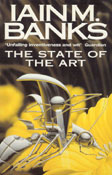 Your science fiction work – especially The State of the Art – seems to be an attempt ‘to see ourselves as others see us’ and has as much political content as your mainstream work, so why do you think that your publishers still insist on separating your science fiction and mainstream work?
Your science fiction work – especially The State of the Art – seems to be an attempt ‘to see ourselves as others see us’ and has as much political content as your mainstream work, so why do you think that your publishers still insist on separating your science fiction and mainstream work?
I suppose it’s because that’s the way the market’s grown up. I start to get annoyed that everything’s compartmentalised, but on the other hand, so many books are being published and you have to arrange them somehow. I don’t see anything wrong with this, but when the ghetto mentality takes over … the attitude from inside the ghetto isn’t too dangerous and is not what you’re worried about, it’s the Nazi guards outside, it’s their attitude. In this particular case, this particular genre called the mainstream novel – the psychological novel, the novel of manners, the Hampstead novel, whatever – is basically saying, ‘We’re top dog, we’re not a genre, we’re the main thing’, and it’s bullshit – they’re a genre.
 Barring the difference of genre, would you make any distinction between your works … say between Use of Weapons and Complicity?
Barring the difference of genre, would you make any distinction between your works … say between Use of Weapons and Complicity?
Not really. I try to bring the same skill to both. The difference is entirely one of setting. In Complicity I had to work in the real world, in Use of Weapons it was a background I had created myself, and one that I feel happier with because it’s a communist utopia where there are zillions of gadgets around and they’re all free! Whereas, in Complicity, you have Thatcherism as a background. I enjoy writing the science fiction more, not tremendously more. In some ways, the mainstream stuff, for want of a better word, is slightly more rewarding by exactly the same fraction, just because it is that much more difficult, so you’ve accomplished more when you’ve done it. But I’m more at home with science fiction.
Iain Banks and Iain M. Banks are not two different people living in the same body then?
No, it’s just me … I have to remember whether it’s an odd or even year to see whether the ‘M’ goes in this year or not. I think Use of Weapons is the second best of all the books.
What’s the best?
The Bridge. It’s been reviewed as a science fiction novel, even though it wasn’t published as such. It’s certainly non-realistic enough to be bordering on SF. There are one or two SF bits and pieces in there.
Can you give us a potted history of your writing career? I believe your first novel was called The Hungarian Lift Jet.
That’s right. I was sixteen and I had just gone from being much influenced by Captain W. E. Johns and Biggles to having just read absolutely everything by Alistair Maclean I could lay my hands on. So it was a spy novel set in contemporary times (1970) and full of sex and violence, neither of which I had any experience of at the age of sixteen.
We won’t be seeing a revised version of The Hungarian Lift Jet, then?
Over my dead body!
The second novel was TTR in 1972?
It stood for The Tashkent Rambler. Well, it did and it didn’t. I’d gone on from Alistair Maclean to Joseph Heller, and TTR was very much a combination of Catch 22 and Stand on Zanzibar by John Brunner. It was set in a near future where there had been a Sino-Soviet border war that hadn’t gone nuclear. The Americans came in on the side of the Chinese because they needed to battle-test their weapons and hadn’t had a decent war for a while. The Chinese take Mongolia from the Soviet Union, but they don’t want it, so the story takes place in the three weeks before the ceremony in which Mongolia is going to become the fifty-first state of the American Union, renamed Mongoliana, and celebrate their Dependence Day … thank you Mr Newman, I was there first.
It’s full of bad puns and characters with names like Dahommey Brezhnev and Dogghart Jammaharry. Gropius Luckfoot was another one, and his very unpleasant sidekick was called Toss Macabre, which looks good in print!
This was the first and last book I ever wrote without a plan, and it ended up at about 400,000 words … like a cancer it kept on growing and growing. Every 50,000 words, I’d try to come up with a new plan to force it to end. The fact that it had about six groups of major characters didn’t help … I’ve never written a book without a proper plan since.
The first version of Use of Weapons came next in 1974?
 The draft that actually exists came largely from a brainwave my pal Ken MacLeod had of how to order and put it together. It’s very complicated the way it works out now, but nothing like as complex as the first draft which is unreadable, even I couldn’t read it, not to mention the acres of purple prose – I went a bit loopy at this point, I think. There were always two things going on in a chapter and there were sixty-four chapters. The book was in two halves, and it was absolutely vital according to the shape of the book that the emotional climax was in the middle – and therefore the second half of the book was an anticlimax. I just put the book aside and said it was unsaveable, but Ken MacLeod said, ‘I think there’s a good book in there trying to get out. Why don’t you try it this way?’
The draft that actually exists came largely from a brainwave my pal Ken MacLeod had of how to order and put it together. It’s very complicated the way it works out now, but nothing like as complex as the first draft which is unreadable, even I couldn’t read it, not to mention the acres of purple prose – I went a bit loopy at this point, I think. There were always two things going on in a chapter and there were sixty-four chapters. The book was in two halves, and it was absolutely vital according to the shape of the book that the emotional climax was in the middle – and therefore the second half of the book was an anticlimax. I just put the book aside and said it was unsaveable, but Ken MacLeod said, ‘I think there’s a good book in there trying to get out. Why don’t you try it this way?’
In a sense, the whole Culture came from the character Zakalwe in The Use of Weapons. I wanted to write about some sort of ultimate mercenary, but not in the sense that he was invincible or invulnerable: a flawed heroic type, the sort of person you’d be very dubious about because he’s a paid killer, but I tried to make it more interesting for him as a character, I wanted to have him fighting on the side of genuine good. I thought, ‘What sort of society do we need?’, and out of that came the Culture. That gave me the chance to answer all the questions I had about the right-wing American space-opera I had been used to reading and which had been around since the 1930s.
Against a Dark Background was first drafted in 1977?
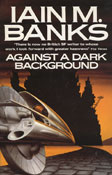 This was meant to be a fantasy novel with a totally rational scientific background, almost taking the piss out of fantasy in a way. Not that this comes over in the book at all, except towards the end where a baddie’s got his diamond crown but Feril says, ‘It’s part of a triple filament drill, actually’. ‘But look at the runes, the runes around the side!’ ‘That’s the serial number actually …’. The whole thing about a team of people with special attributes reforming and then going off on multiple quests is meant to be like a fantasy novel but not in a fantasy setting. It’s probably the one that’s changed the least out of all the novels.
This was meant to be a fantasy novel with a totally rational scientific background, almost taking the piss out of fantasy in a way. Not that this comes over in the book at all, except towards the end where a baddie’s got his diamond crown but Feril says, ‘It’s part of a triple filament drill, actually’. ‘But look at the runes, the runes around the side!’ ‘That’s the serial number actually …’. The whole thing about a team of people with special attributes reforming and then going off on multiple quests is meant to be like a fantasy novel but not in a fantasy setting. It’s probably the one that’s changed the least out of all the novels.
The State of the Art dates from 1979.
This was going to be a longish short story but it turned out to be longer than I thought – a novella. Having invented the Culture, I started playing around with it and thought, ‘Hey! Wouldn’t it be fun if I got Earth and the Culture together,’ And once I got the idea that the Earth would be used as a control planet, I had to write it because that was such a neat way to end it … yes, they’re here, but they’re just going to watch.
Next came The Player of Games in 1980.
 Superficially the published version is very similar to the first draft, except that, in the first version, Gurgi leaves the Culture just because he gets bored, no other motive, he’s not blackmailed or anything, and this means you miss out on the surprise ending. It’s much more complex and darker in the rewritten form. The original draft still exists within the finished book in a sense.
Superficially the published version is very similar to the first draft, except that, in the first version, Gurgi leaves the Culture just because he gets bored, no other motive, he’s not blackmailed or anything, and this means you miss out on the surprise ending. It’s much more complex and darker in the rewritten form. The original draft still exists within the finished book in a sense.
Then The Wasp Factory was written in 1981.
There were only about half a dozen publishers for hardback SF, and I wasn’t getting anything published. The idea of writing something I could send to more publishers set off a big internal debate with myself. The radical faction was saying, ‘You’re selling out here, you’re a science fiction writer. How dare you write other books?’ While the more pragmatic side of me was saying, ‘If it gets you published, then you’ll be able to write science fiction as well.’ In the end, The Wasp Factory was what came out of that.
Were you aware of how controversial it would be?
No. When I was writing it, there were even times when I thought, ‘No-one’s going to want to read this, this is boring’. That was usually when I threw in another phone call from Eric to lift the pace. It never occurred to me that the book was going to be as controversial as it was.
Consider Phlebas followed in 1982.
Very similar to the published version. I was getting better.
What about Walking on Glass?
Walking on Glass was written before The Wasp Factory was published – I had that ‘always tricky’ second novel out of the way before the first one came out.
I believe your next novel was called Q and was written in 1984, but remains unpublished?
This was meant to be the third novel, but my editor said, ‘Look, you can probably sell this somewhere. Three or four publishers in London would leap at the chance and give you a lot more money for it than we can. But I don’t think it’s good enough. You should throw it away.’ So I thought about it, and said ‘Okay’. It was a big bastard too, about 180,000 to 190,000 words long.
Did you cannibalise Q for The Bridge?
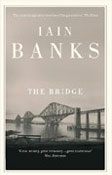 Q starts with a guy lying in the desert with a big ‘O’ imprinted on his chest. There are vultures hovering overhead. The vultures come down because he’s on his last legs, but he gets one of them, drinks its blood and finds the strength to go on: that tiny little bit ended up late on in The Bridge, the book I wrote instead. I think The Bridge is my best book, the most complicated and bravura.
Q starts with a guy lying in the desert with a big ‘O’ imprinted on his chest. There are vultures hovering overhead. The vultures come down because he’s on his last legs, but he gets one of them, drinks its blood and finds the strength to go on: that tiny little bit ended up late on in The Bridge, the book I wrote instead. I think The Bridge is my best book, the most complicated and bravura.
Parallels have been made between The Bridge and Lanark.
I was absolutely knocked out by Lanark. I think it’s the best in Scottish literature this century. It opened my eyes. I had forgotten what you could do – you can be self-referential, you can muck about with different voices, characters, time-streams, whatever. Lanark had a huge effect on The Bridge. I’m quite happy to acknowledge that debt.
I believe the music referred to in Espedair Street, written in 1986, dates back to the Seventies.
The book is mostly set in the early Seventies and the music and even the embarrassing lyrics work in it because they are of that time. I know all those tunes, and though I have no musical skills at all I can imagine every riff in my head.
How do you feel now about Canal Dreams from 1988?
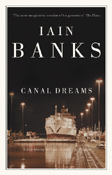 This is probably the weakest of the books. It’s okay, but it’s the one I’m least proud of, and the book I found the most difficult to write. I was in the wee flat I had at the time on the South Bridge in Edinburgh. I’d keep the word processor on all day, sit down, look at it, go away, vacuum the flat … then at midnight I’d have a whisky and think, ‘I might as well go through what I did yesterday,’ and then I’d work through to dawn, but drinking vast amounts of whisky … it’s the only book I’ve written under the influence of drugs.
This is probably the weakest of the books. It’s okay, but it’s the one I’m least proud of, and the book I found the most difficult to write. I was in the wee flat I had at the time on the South Bridge in Edinburgh. I’d keep the word processor on all day, sit down, look at it, go away, vacuum the flat … then at midnight I’d have a whisky and think, ‘I might as well go through what I did yesterday,’ and then I’d work through to dawn, but drinking vast amounts of whisky … it’s the only book I’ve written under the influence of drugs.
Canal Dreams was just too far outside my scope. I had intended to go to Panama, but the US was starting to destabilise Noriega at the time. I couldn’t afford to go to Japan and so I was working from guide books … doing a middle-aged Japanese lady cello player was probably a little hubristic.
One of the problems of the book is that it would be so easy to turn it from being left-of-centre to being right-of-centre, simply by removing the ending. That’s why I don’t want to sell it to Hollywood. I’d sell it if Oliver Stone was interested, there’s nobody else I could trust. But he’s been there and done that.
Are you happier with The Crow Road which came out in 1991?
I was pleased with it in the end, even though structurally it’s all over the place, a rag-bag of a thing. I like the characters in The Crow Road, especially Prentice, and, as my editor pointed out two days ago, ‘You always fall in love with your women characters, don’t you, Banksie? And it always shows as well.’ Oops!
What generated the fury of Complicity in 1992?
This was written because I thought The Crow Road was far too cosy and I was starting to react against that. I thought, ‘I’m approaching my forties and people are going to think ‘That’s Banks over the hill, he can’t write anything dangerous any more’ … I’ll show them what’s dangerous’. I had all these violent deaths and bizarrely inventive murders which I couldn’t find a home for … couldn’t do myself! And I did want to write something about Thatcherism and the Eighties. I had wanted to write a whodunnit for a long time, and it all came together nicely. Also, I was keen on doing something set in Edinburgh, which I thought hadn’t been written about enough and really deserved it. It’s a strange city in a lot of ways with all its wee wynds …
Was Complicity the completion of a cycle … it falls at the end of your first decade of work?
I felt that The Crow Road and Against a Dark Background were the end of it. Complicity is a bit like The Wasp Factory, so it’s the cycle starting again. Against a Dark Background was the last of the old books to get redone, so it seemed like the end of an era to me.
 And so Feersum Endjinn is the first SF book of the new cycle?
And so Feersum Endjinn is the first SF book of the new cycle?
I had wanted to write something I could cut loose on, something that wasn’t the Culture … I’ll go back to that in the next science fiction novel. I liked the exotic feel of Against a Dark Background and wanted to do something like that on Earth. I thought the big structures in Against a Dark Background hadn’t been big enough, so I came up with the mega castle which was originally a space elevator. I also had the idea that what virtual reality would become eventually would start to resemble myth and legend. I wanted to use different voices as well.
Do you ever feel under commercial pressure?
I get no shit from my publishers. I’ve never had any pressure from Macmillan or Little, Brown. They always seem quite happy. I hear of other writers getting told to do things …
What can you tell me about your new novel?
It was going to be called Whit, then it was going to be called Twenty-nine … we might even be a bit cheeky and try and get away with calling it Cult Novel. It’s set in May of this year, so I’m writing it ahead of time … there’s a reason for this. It’s about a cult which is based on a family but has lots of other members as well. The cult originally starts out in the Hebrides in 1948 when this guy appears from nowhere one dark and stormy night on the dunes and bumps into two ostracised Asian women who live and work in an old ex-library van they’re using as a travelling shop. He has a vision and starts this cult, which eventually gets the gift of an estate near Stirling in the flood plain of the Forth. One of the central things these cult members believe is that you do things not on the main highways of life, but by sticking to the back alleys …
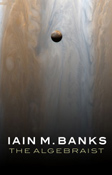
Copyright Andrew Wilson 1994.

Comments